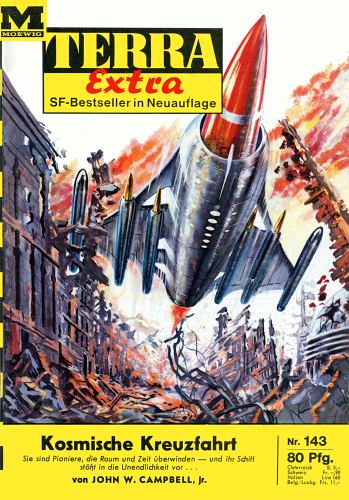John W. Campbell : Kosmische Kreuzfahrt
Terra Extra 143, 19.05.1967
Neuauflage
Deutsche Erstausgabe BALOWA 1959
Originalausgabe AMAZING 1931
erweiterte Fassung FANTASY PRESS 1956
Aus dem Amerikanischem von Fritz Moeglich
Titelbild : Johnny Bruck
J. W. Campbell Jr. ist mit seinem Roman "Der unglaubliche Planet" in Deutschland durchaus bekannt und eingeführt. Wenn unser Verlag nun den Roman "Islands in Space" einem kritischen Leserpublikum vorlegt, dann setzt er damit die Linie fort, die in den bisherigen Bänden der Reihe "Bestseller des Komos" zum Ausdruck kam. Dieses Werk des amerikanischen Spitzenautors ist das, was die Kenner eine "Brillante Space Opera" nennen - eine spannende Handlung, in der die Technik einer fernen Zukunft triumphiert.Klappentext des BALOWA-Leihbuchs
Dr. Arcot und sein Team reisen mit einem phantastischen Schiff durch Raum und Zeit. Sie erleben Kampf und Not, Sieg und Untergang - und die unfaßliche Weite des Kosmos ist ihr Feld. Millionen Lichtjahre trennen die Besatzung des "Pionier" von der Erde, und vier Männer bezwingen die Schrecken der Unendlichkeit.
Reisen Sie mit dem "Pionier" in eines der großartigsten Abenteuer, das uns bisher die Science Fiction vermittelte.
In the early part of the Twenty Second Century, Dr. Richard Arcot, hailed as "the greatest living physicist", and Robert Morey, his brilliant mathematical assistant, discovered the so-called "molecular motion drive", which utilized the random energy of heat to produce useful motion.Prolog
John Fuller, designing engineer, helped the two men to build a ship which used the drive in order to have a weapon to seek out and capture the mysterious Air Pirate whose robberies were ruining Transcontinental Airways.
The Pirate, Wade, was a brilliant but neurotic chemist who had discovered, among other things, the secret of invisibility. Cured of his instability by modern psychomedical techniques, he was hired by Arcot to help build an interplanetary vessel to go to Venus.
The Venusians proved to be a humanoid race of people who used telepathy for communication. Although they were similar to Earthmen, their blue blood and double thumbs made them enough different to have caused distrust and racial friction, had not both planets been drawn together in a common bond of defense by the passing of the Black Star.
The Black Star, Nigra, was a dead, burned-out sun surrounded by a planetary system very much like our own. But these people had been forced to use their science to produce enough heat and light to stay alive in the cold, black depths of interstellar space. There was nothing evil or menacing in their attack on the Solar System; they simply wanted a star that gave off light and heat. So they attacked, not realizing that they were attacking beings equal in intelligence to themselves.
They were at another disadvantage, too. The Nigrans had spent long millennia fighting their environment and had had no time to fight among themselves, so they knew nothing of how to wage a war. The Earthmen and Venusians knew only too well, since they had a long history of war on each planet.
Inevitably, the Nigrans were driven back to the Black Star.
The war was over. And things became dull. And the taste of adventure still remained on the tongues of Arcot, Wade, and Morey.
Den habe ich zwar erst letztens, als TERRA SF 152, gelesen, war aber nett, den wiederzulesen. Der Roman ist einer der Fälle, in denen die Kürzungen positiv zu Buche schlagen. Das Original kann man - so man denn hartgesotten ist - auf gutenberg.org nachlesen. In der hier vorliegenden Form ist er einer der frühen Romane des Golden Age, der den Sense of Wonder und das Gefühl, das alles möglich ist, gut zu dem Leser transportiert.

Keine Kommentare:
Kommentar veröffentlichen